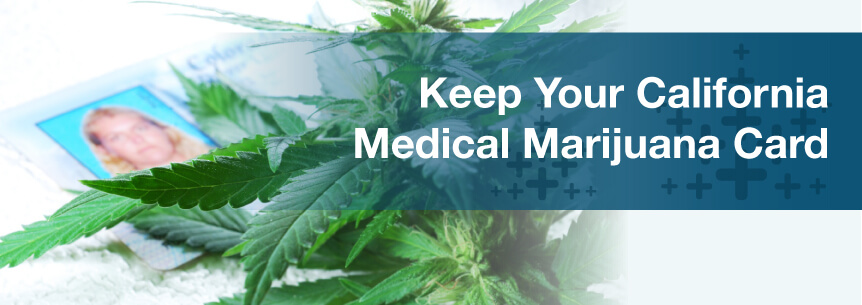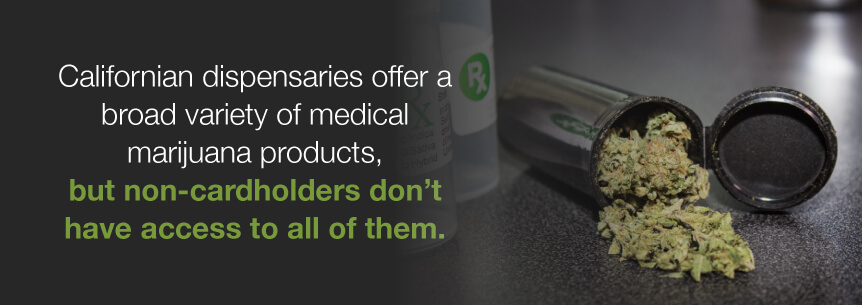
California patients no longer have to carry a medical cannabis card to buy marijuana. In November 2016, California residents voted to legalize recreational marijuana sales in their state. A total of 56 percent of voters said “yes” to Proposition 64, changing the shape of cannabis laws in the Golden State.
Proposition 64 came into effect on January 1, 2018. With the beginning of the new year came the ability to buy recreational marijuana like alcohol. Anybody 21 or over with a government ID can visit a recreational dispensary and buy cannabis.
If you have a California medical marijuana ID, you may feel tempted to let it expire. After all, if you only need a government ID card now, what’s the point of putting in the time, effort and money? Patients can still reap plenty of benefits from a medical marijuana program membership in California.
The most obvious reason to keep your medical marijuana card in California is to have access to medicine even as someone under 21. Patients who are underage must have a recommendation and card to obtain and use medical marijuana legally.
Plus, just because California has liberal cannabis laws for a U.S. state doesn’t mean you still can’t get in trouble with the federal government for using marijuana medicine. Having a card gives you extra security and documentation you can use to protect your rights.
Californian medical marijuana patients get tax breaks recreational users don’t benefit from. While it costs money to sign up for a state-issued green card, the extra savings can make up for it if you make frequent dispensary purchases.
To register for a state medical marijuana ID, you need to pay a registration fee of $100, or $50 if you have Medi-Cal. But, you don’t have to pay sales and use tax, which can net you reduced medication costs. Sales and use tax varies depending on the city and county you live in. So, if you live somewhere with a high sales and use tax, you can skip paying it and save money.
Californian dispensaries offer a broad variety of medical marijuana products, but non-cardholders don’t have access to all of them. Since recreational products can only have up to a certain level of THC, they have to come in specific forms. This rule mainly applies to edibles due to serving sizes.

An edible product can’t contain more than 100 milligrams of THC. Plus, the product has to be separated into servings that don’t exceed 10 milligrams of THC. So, without a medical marijuana card, you can’t buy single-serving edibles with larger concentrations. Topicals and tinctures with higher THC content are off the table, too.
As you can see, the smaller selection recreational users have is connected to the concentration of cannabinoids they can legally access. Not only can medical cannabis patients purchase more kinds of products, but they can also use products with a higher amount of THC.
You can see this difference when you check out your dispensary’s inventory of topicals and tinctures. The regular THC limit for these kinds of products is 1000 milligrams, but medical marijuana patients can buy tinctures and topicals containing up to 2000 milligrams of THC.
One of the biggest benefits of having a California green card is the increased possession limit. Usually, you can only carry one ounce of marijuana at a time. But with a medical marijuana ID, you can possess much more cannabis.
Medical marijuana laws state that a patient can have as much cannabis as they medically need. Although many cities and counties have their own limits for patient possession, they’re generally much more lenient than the recreational possession limit. For example, patients in San Francisco can have up to eight ounces.
In addition to carrying one ounce of marijuana, California residents can grow up to six cannabis plants at home. Depending on your needs, six plants might be enough for you to follow your treatment plan. But, some people need more medicine and have limited access to dispensaries.
Just like possession limits, cultivation limits go up when you have a medical cannabis ID. This increase gives patients in need more control over their medication — the limit depends on where you live. San Francisco patients can grow up to 24 plants.
Since many cannabis businesses and lawmakers are still working out the kinks, California has fewer recreational dispensaries than medical dispensaries. Medical dispensaries already exist, so patients don’t have to wait for them to open. Keeping your card lets you obtain medication without waiting for a new dispensary to pop up.
Plus, some areas don’t have recreational dispensaries at all. Cities like Los Angeles and San Francisco set a later start date for recreational sales, creating a longer wait for folks without a card. Even if you think the laws for recreational users are enough for your needs, you may not have guaranteed access to medicine without a medical marijuana ID.
Patients will benefit the most from holding on to their medical marijuana ID cards if they:
Of course, you may have another reason for wanting the liberties that medical marijuana patients have. Think about your medical needs and how they line up with California laws.
With the introduction of recreational marijuana laws, California will probably have to make some amendments to their legislation. Follow our news updates to keep track of any changes that happen.
To stay safe and legal, you should have a good grasp on current cannabis laws, too. Our guide to California medical marijuana laws provides an overview of what you need to know.
No Information on MarijuanaDoctors.Com should be used to diagnose, treat, prevent or cure any disease or condition. You can view our Full Disclaimer here.